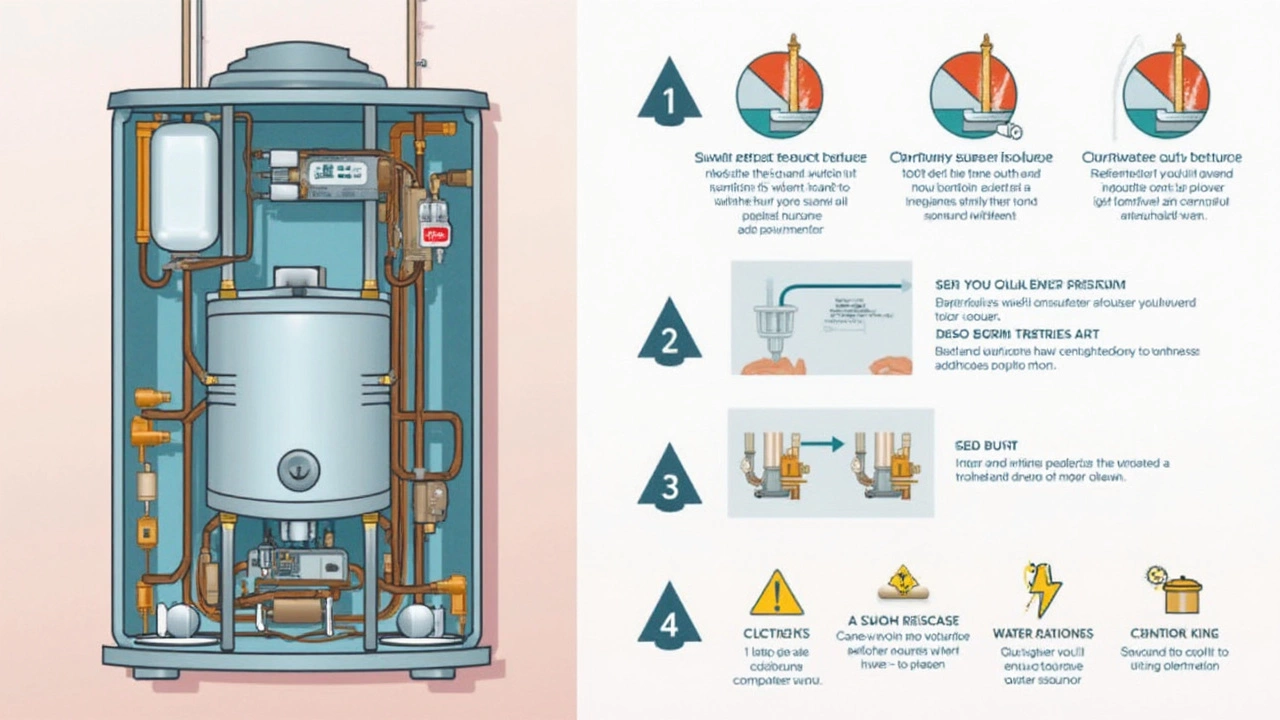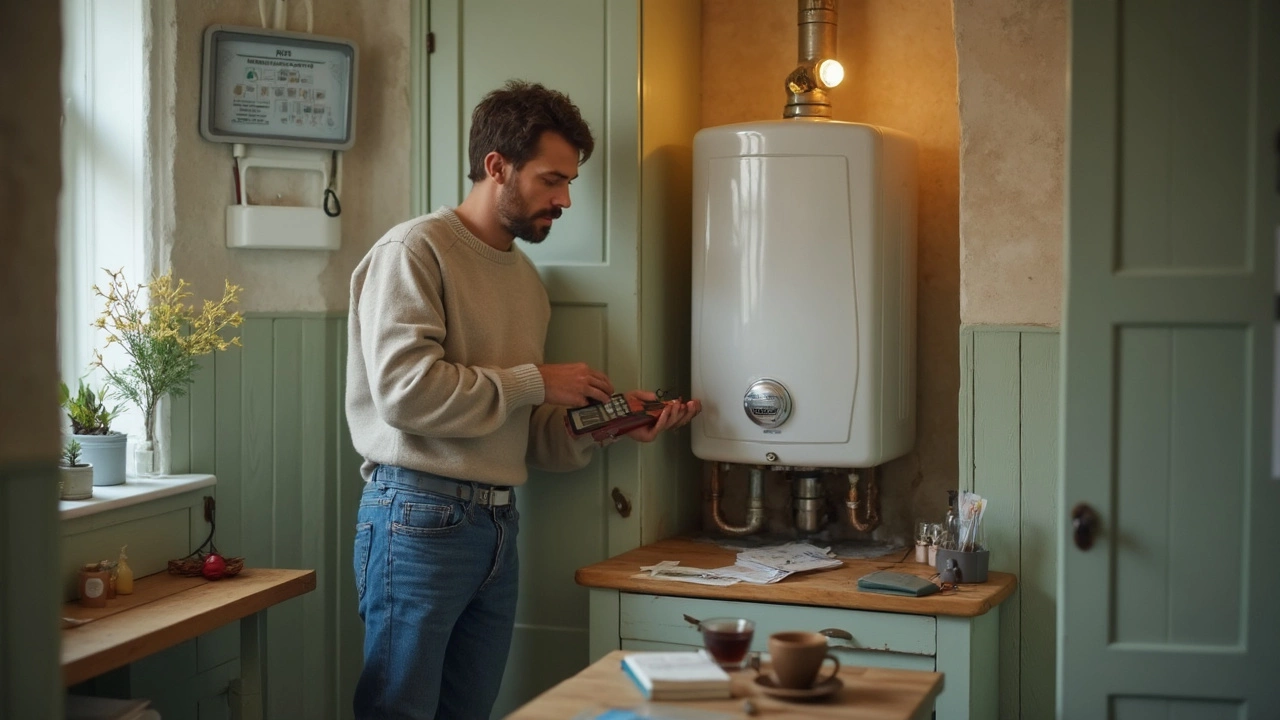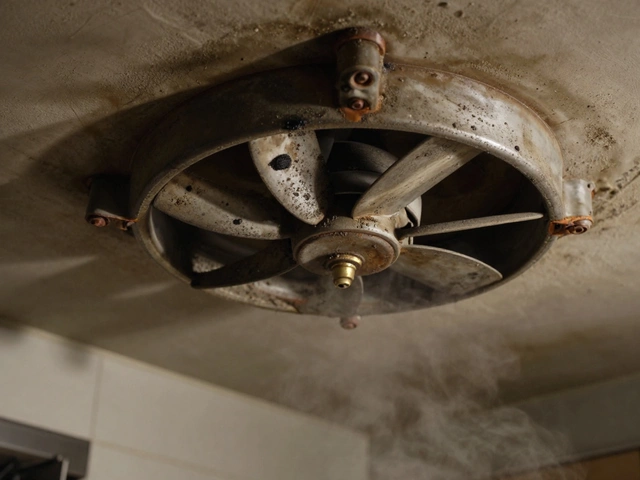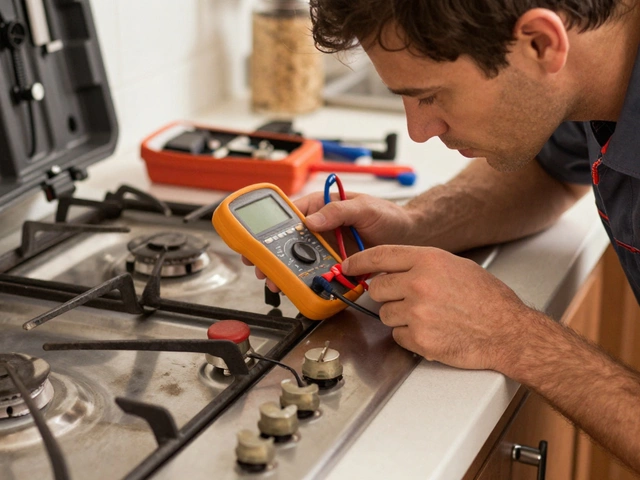Ever pressed that little red button on your water heater and hoped for hot water magic? You’re not alone. The water heater reset button is basically a built-in safety net. When something’s up with the temperature or wiring, it trips—cutting power to stop things from getting dangerous. Kinda like hitting a panic button for your tank.
But here’s the thing most folks don’t realize: that button is warning you. Your heater shouldn’t need a reset under normal conditions. If it does, you’ve probably got a deeper problem—maybe a bad heating element, faulty thermostat, or old wiring.
Resetting the heater might give you hot water for a bit, but it’s not a fix. It’s more like putting duct tape on a leaky pipe. Sure, things work for now, but you’re risking overheating, electric shocks, or even leaks down the line. And trust me, it’s no fun when you find water pooling on the floor at 2 a.m.—my dog Rex is still scared of puddles after our last heater leak.
- What Does the Reset Button Do?
- Why Do Water Heaters Need Resetting?
- When Is It Actually Safe to Reset?
- Risks and Problems After Resetting
- DIY Tips Before Calling a Pro
- Prevention and Regular Maintenance
What Does the Reset Button Do?
The reset button—usually a red button tucked behind a small panel on your water heater—acts like your water tank’s safety switch. When something goes wrong, like overheating or a wiring problem, this button pops out and instantly shuts off power to the heating elements. It’s not just any button; it’s officially called the Energy Cut Off (ECO) switch. The main job? Stop things from getting risky, like dangerously high water temps or even an electrical fire.
Electric water heaters use thermostats to control how hot the water gets. If the main thermostat or backup fails, water can get hotter than it’s supposed to. Once temps hit around 180°F (82°C), the reset button disconnects power. It’s basically a final line of defense if something in your water heater misbehaves.
Here’s the quick rundown on what triggers the reset button:
- Overheating – Maybe the thermostat’s stuck or a heating element won’t shut off.
- Faulty parts – Bad wiring, broken thermostat, or failing heating element mess up temperature readings.
- Power surges – Fluctuations in your home’s electricity can trip the button.
- Water leaks – Water in the wrong spot can mess with the electrical parts and cause the switch to activate.
Just hitting reset might let you get hot water again, but remember: the button tripped for a reason. Ignoring it or constantly resetting can actually make things worse or even unsafe over time. If your water heater keeps needing resets, you probably need to look deeper—not just rely on that button.
Here's a quick look at what the reset button is protecting you from:
| Trigger | What Could Happen | Reset Button's Action |
|---|---|---|
| Overheated water | Scalding risk, tank damage | Shuts off power immediately |
| Faulty wiring | Shock hazard, potential fire | Cuts power to elements |
| Electrical surge | Component damage | Trips and stays off |
So, the humble reset button isn’t a magic fix. It’s a warning signal. Pay attention when it trips—it’s looking out for you and your home.
Why Do Water Heaters Need Resetting?
If you’ve had to press the reset button on your water heater more than once, something’s going wrong under the hood. The reset water heater button isn’t built for casual use—it’s meant to stop things from getting unsafe when your system detects trouble.
One big reason for resets is a faulty thermostat. If the thermostat fails, the water can get way too hot, which is dangerous. Electric water heaters have a safety trip that cuts power before things get out of hand. Another common culprit? A broken heating element. If the element shorts out, it overheats the tank or wiring, and you’ll find yourself reaching for that red button.
- Water heater safety also comes into play with wiring and power surges. Loose or old wires can make your heater act up, causing those surprise shutdowns.
- Sometimes, sediment builds up in the tank. When gunk coats the heating elements, they overheat, and the safety switch flips.
- Unexpected power outages or electrical glitches (like a lightning strike) can trip the reset button, too. The reset is basically saying, “Hey, something weird just happened, let’s stop before it gets worse.”
Here's a quick look at why resets might happen, with some numbers I’ve run into talking to local plumbers here in town:
| Reason | Percentage of Cases |
|---|---|
| Failed Thermostat | 40% |
| Bad Heating Element | 30% |
| Sediment Buildup | 15% |
| Electrical Glitch | 10% |
| Other Issues | 5% |
Resetting the water heater could get you hot water again, but if the root problem isn’t solved, it’s only temporary. Listen to your water heater—it’s raising a flag for a reason. And remember, hitting the reset button too often is a sign your water heater repair should be on top of your to-do list, not just a Band-Aid fix.
When Is It Actually Safe to Reset?
It's tempting to hit the reset water heater button and get on with your day, but that’s not always the best call. Resetting your water heater is only truly safe in a couple of specific situations—otherwise, you're masking hidden issues.
If your heater tripped due to a temporary power outage, a one-time electrical blip, or because the tank overheated after high use (like after all the kids have had long hot showers), you're usually fine to reset once. These are cases where nothing’s wrong with the heater itself—the problem came from outside, like your house circuit breaker flipping if you plugged in too much stuff at once.
Here’s when a reset water heater move is generally considered safe:
- First trip after a known outage or surge: Power flickered in your area? Try resetting once the lights are steady.
- Unusual burst of hot water demand: Maybe you ran a bunch of loads in the washer and baths back to back. Let the tank cool down, then reset.
- No signs of leaks or burn marks: Always check the floor and the heater for water puddles, scorch marks, or weird smells before resetting.
Never reset if:
- You see water leaking from the heater or pipes.
- The breaker keeps tripping again and again.
- You spot burnt areas, melted insulation, or detect a strong electrical odor.
For most brands, one reset after a clear issue—like the power going out—is okay. But if you’re constantly relying on that button, you’re ignoring your heater’s SOS signal.
According to the 2023 U.S. Consumer Product Safety Commission, about 13% of residential fires linked to electric water heaters happened after repeated resets without fixing the underlying issue. It's just not worth the risk.
Bottom line: Only push your reset water heater button if you have a clear, harmless reason for the trip, and only after checking for obvious danger signs. Otherwise, get it checked out. Your nerves—and your electric bill—will thank you.

Risks and Problems After Resetting
Hitting the reset button on your water heater isn’t always a harmless move. It might get things running for a while, but there’s a reason that safety system is tripping in the first place. Ignoring what’s really happening under the hood can mean bigger headaches later.
One of the biggest risks: overheating. If your thermostat’s stuck or a heating element is shot, resetting just forces the system back on, and that can send your water temp through the roof. That’s actually how scalds and burns happen—especially if you have kids messing with the tap. Not worth it.
If faulty wiring is to blame, you could also be rolling the dice with electrical shocks or even a fire. According to data from the National Fire Protection Association, water heaters are involved in thousands of home fires each year—bad wiring is a huge culprit. Not exactly something you want to gamble with.
There’s also the slow leaks and water damage that come from constant resets. If the pressure valve or tank itself is the issue, you might end up with water where it definitely shouldn’t be. And trust me, cleaning up a wet utility room is no fun (Rex hates it, too). Here’s a quick breakdown of common problems you risk by using the reset like a band-aid:
- Repeated tripping due to underlying thermostat or heating element failure
- Tank overheating, causing pressure to build up (which can burst the tank)
- Scalding hot water risk from unregulated temperatures
- Electrical shock or fire from damaged wiring and poor connections
- Leaks and water damage from failing valves or rusted tanks
So, if your reset water heater trick becomes a routine, it’s a signal. Quick resets can mask the real problem and set you up for costly repairs—or worse, a safety emergency. That’s why using the reset button is a short-term thing at best, not a real water heater repair solution.
DIY Tips Before Calling a Pro
Before shelling out money for a plumber or electrician, there are a few simple things you can check on your own. Just remember, always shut off the power at the circuit breaker before poking around the water heater. That's not just good advice—it's how you avoid serious shocks.
- Check for a tripped breaker. Sometimes, it’s just the circuit breaker in your electric panel. Flip it fully off, then on again. If it trips again right away, there’s likely a bigger electrical issue.
- Make sure the thermostat is set correctly. Some heaters have a little dial behind a metal panel. Set it between 120°F and 140°F—hot enough for showers but not dangerous.
- Look for obvious signs of leaks or pooling water around the tank. Even a small leak can cause electrical components to short out and trip the reset button. If it’s dry, you’re in the clear here.
- Push the reset button (usually red). Hold it for about 5 seconds, then release. If you hear a click, you’ve done it right. If the *reset water heater* button pops right back out, there’s probably a heating element or wiring problem you shouldn’t try to DIY.
Pay attention to the age of your heater. Most models last 8-12 years. If you’re resetting it every week and it’s older than your dog, it’s probably time for a replacement, not another repair.
About 20% of all water heater calls are for problems you can actually spot without tools. Here’s a quick table with common signs versus what they usually mean to help you troubleshoot:
| What You Notice | What It Could Mean |
|---|---|
| No hot water even after reset | Bad heating element or thermostat |
| Reset trips after a few hours | Electrical short, leak, or faulty wiring |
| Water leaking from tank | Cracked tank or loose connection |
| Strange noises (pops, bangs) | Sediment buildup inside tank |
If the *reset water heater* button keeps tripping or you spot burn marks near wiring, don’t risk it. That’s a job for someone with the right tools and training. These quick checks just help you know what’s up before you pick up the phone.
Prevention and Regular Maintenance
Most people only think about their water heater after a cold shower. But sticking to regular check-ups is the real secret to avoiding those surprise resets and big repairs. Here’s what actually helps keep your water heater running safely.
- Test the reset button: Once every few months, quickly tap the reset button (when the tank is cool). If it trips too easily or won’t reset, something’s off. Better to know before things get worse.
- Drain and flush the tank: Sediment builds up at the bottom. For most heaters, draining a few gallons from the tank every 6 to 12 months can prevent the heating element from getting buried and failing. Less gunk, fewer problems with the reset water heater cycle.
- Check the thermostat: Set it to 120°F (49°C). A higher temp wastes energy and wears out components quicker. Plus, keeping it at 120°F cuts the risk of scalds, especially if you’ve got kids.
- Inspect wiring and insulation: Look for frayed wires, rust, or leaky spots. And if your tank feels hot to the touch, you may want more insulation around it.
- Replace the anode rod: This part stops the tank from rusting. Most rods last three to five years. If it’s gone, your heater’s next on the menu for rust.
| Maintenance Task | How Often |
|---|---|
| Test reset button | Every 3 months |
| Flush tank | Every 6-12 months |
| Check thermostat | Every 6 months |
| Inspect wiring | Every 6 months |
| Replace anode rod | Every 3-5 years |
None of this takes a pro unless you spot real trouble—like burned wires or tank leaks. But routine checks save money and headaches down the road. Add these tasks to your calendar. Your water heater repair budget (and maybe your nerves) will thank you.





